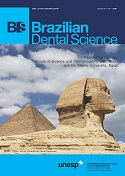Total protein level reduction of odontopathogens biofilms by Rosmarinus officinalis L. (rosemary) extract: an analysis on Candida albicans and Streptococcus mutans
DOI:
https://doi.org/10.14295/bds.2019.v22i2.1679Abstract
Objective: The resistance of fungi and bacteria to the available antimicrobials has increased and the development of alternative products to control them has become a very requirement. The use of plant products could be a viable option due to the efficacy, viability, and availability they present. Thereby, this study evaluated the effect of R. officinalis L. extract on C. albicans and S. mutans biofilms, by the total protein level analysis presented by the microorganisms. Material and Methods: For this purpose, monomicrobial biofilms were formed for 48 h and exposed to the R. officinalis L. extract for 5 min. Then, total protein quantification was performed by Lowry method. Results: The analysis showed significant total protein reduction of the biofilms after exposure to the plant extract, with 39 ± 11%, for C. albicans, and 32 ± 11%, for S. mutans. Conclusion: R. officinalis L. extract decreased the total protein level in both biofilms. Thus, C. albicans and S. mutans protein composition could be a target for action of antimicrobial agents.
Keywords
Biofilms; Candida albicans; Proteins; Rosmarinus officinalis; Streptococcus mutans.
Downloads
Downloads
Published
How to Cite
Issue
Section
License
Brazilian Dental Science uses the Creative Commons (CC-BY 4.0) license, thus preserving the integrity of articles in an open access environment. The journal allows the author to retain publishing rights without restrictions.
=================




























